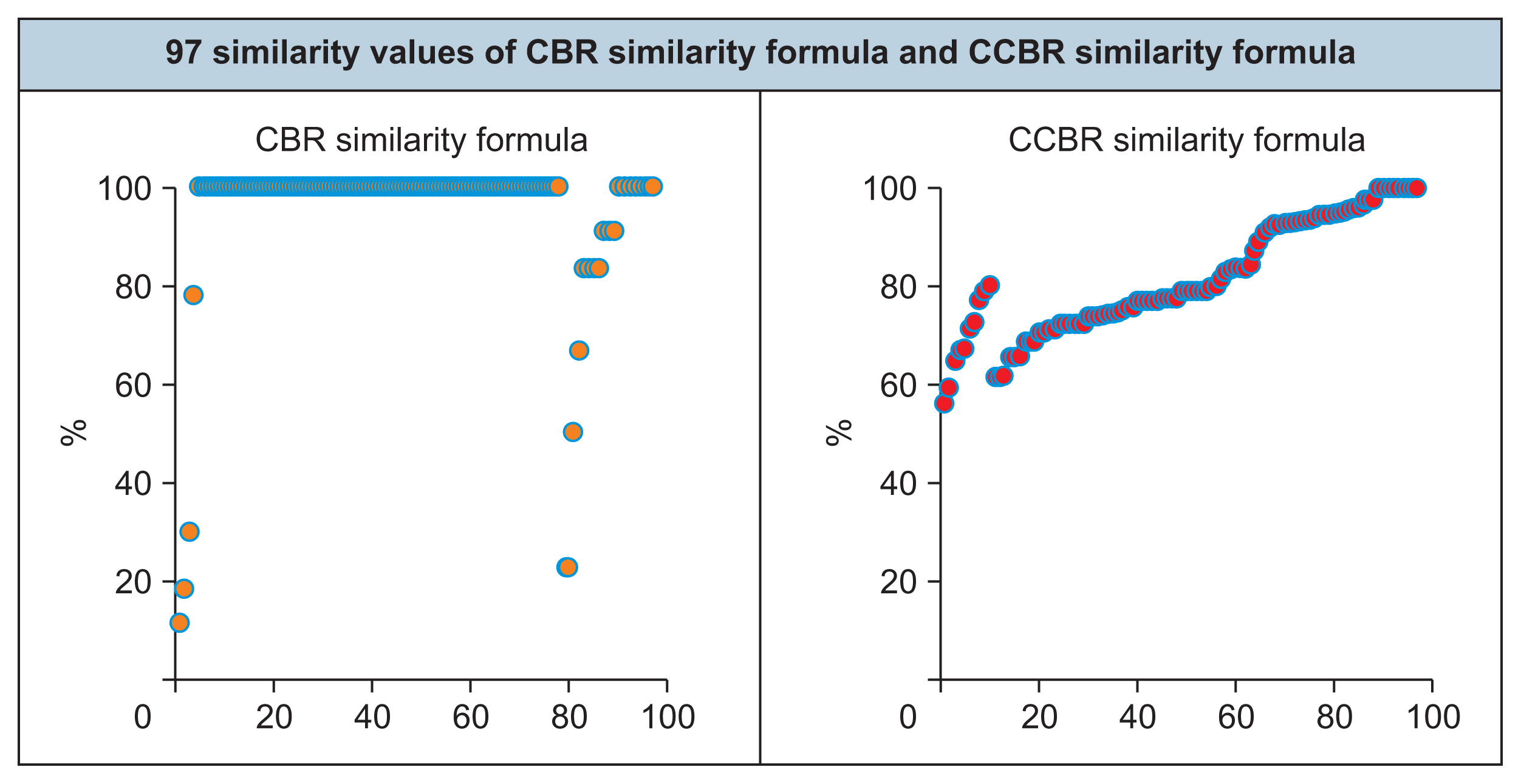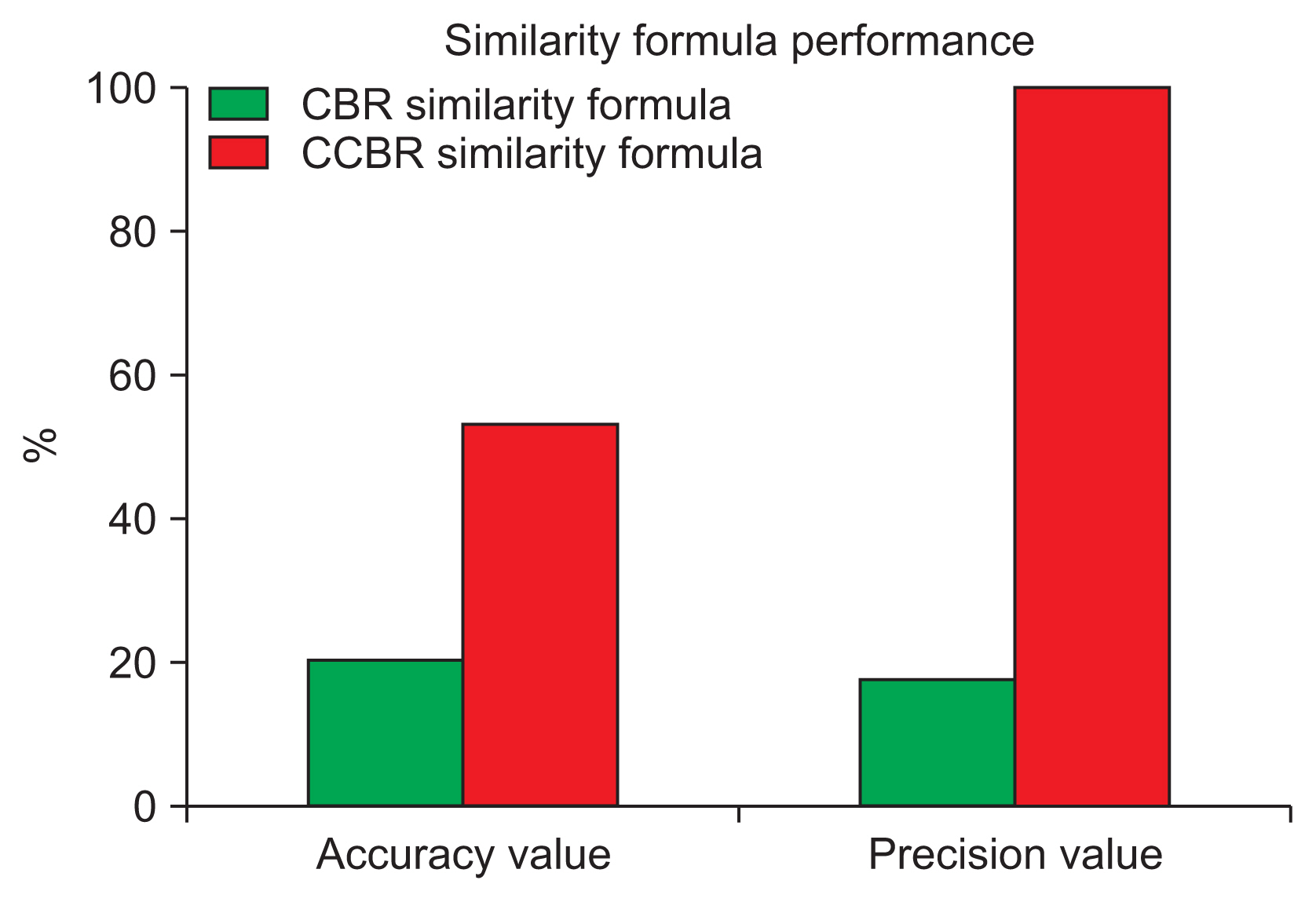Healthc Inform Res.
2022 Jul;28(3):267-275. 10.4258/hir.2022.28.3.267.
Modification of Case-Based Reasoning Similarity Formula to Enhance the Performance of Smart System in Handling the Complaints of in vitro Fertilization Program Patients
- Affiliations
-
- 1Department of Computer Science, Satya Wacana Christian University, Salatiga, Indonesia
- 2College of Informatics and Computer Management (STMIK), Widya Pratama, Pekalongan, Indonesia
- KMID: 2532454
- DOI: http://doi.org/10.4258/hir.2022.28.3.267
Abstract
Objectives
Eighty percent of in vitro fertilization (IVF) patients have high anxiety levels, which influence the success of IVF and drive IVF patients to quickly report any abnormal symptoms. Rapid responses from fertility subspecialist doctors may reduce patients’ anxiety levels, but fertility subspecialist doctors’ high workload and their patients’ worsening health conditions make them unable to handle IVF patients’ complaints quickly. Research suggests that smart systems using case-based reasoning (CBR) can help doctors handle patients quickly. However, a prior study reported enhanced accuracy by modifying the CBR similarity formula based on Lin’s similarity theory to generate the Chris case-based reasoning (CCBR) similarity formula.
Methods
The data were validated through interviews with two fertility subspecialist doctors, interviews with two IVF patients, a questionnaire administered to 17 community members, the relevant literature, and 256 records with data on IVF patients’ complaints and how they were handled. An experiment compared the performance of the CBR similarity formula algorithm with the CCBR similarity formula algorithm.
Results
A confusion matrix showed that the CCBR similarity formula had an accuracy value of 52.58% and a precision value of 100%. Fertility subspecialist doctors stated that 89.69% of the CCBR similarity formula recommendations were accurate.
Conclusions
We recommend applying a combination of the CCBR similarity formula and a minimum reference value of 80% with a CBR smart system for handling IVF patients’ complaints. This recommendation for an accurate system produced by the CBR similarity formula may help fertility subspecialist doctors handle IVF patients’ complaints.
Figure
Reference
-
References
1. Hanoum IF, Boediono A, Pangestu M, Haryadi D, Widad S, Dasuki D. Microvolume of 0.1 μL gama sleeved cryoloops for blastocyst vitrification of assisted reproductive technology patients. Jurnal Kesehatan Reproduksi. 2015; 2(1):47–52. https://doi.org/10.22146/jkr.7127.
Article2. Christianto PA, Sediyono E, Sembiring I. Case-based reasoning modifications for intelligent systems in handling in vitro fertilization (IVF) patients post embryo transfer. In : Proceedings of 2020 International Seminar on Application for Technology of Information and Communication (iSemantic); 2020 Sep 19–20; Semarang, Indonesia. p. 109–14. https://doi.org/10.1109/iSemantic50169.2020.9234270.
Article3. Christianto PA, Sediyono E, Sembiring I, Wijono S. Intelligent system of handling in vitro fertilization (IVF) patients post embryo transfer to reduce the level of patient anxiety and help fertility doctors quickly answer patient questions. In : Triwiyanto , Nugroho HA, Rizal A, Caesarendra W, editors. Proceedings of the 1st International Conference on Electronics, Biomedical Engineering, and Health Informatics; Singapore: Springer;2021. p. 183–96. https://doi.org/10.1007/978-981-33-6926-9_17.
Article4. Bennett L, Pangestu M. Regional reproductive quests: cross-border reproductive travel among infertile Indonesian couples. Asia Pac Viewp. 2017; 58(2):162–74. https://doi.org/10.1111/apv.12160.
Article5. Guven PG, Cayir Y, Borekci B. Effectiveness of acupuncture on pregnancy success rates for women undergoing in vitro fertilization: a randomized controlled trial. Taiwan J Obstet Gynecol. 2020; 59(2):282–6. https://doi.org/10.1016/j.tjog.2020.01.018.
Article6. Capuzzi E, Caldiroli A, Ciscato V, Zanvit FG, Bollati V, Barkin JL, et al. Is in vitro fertilization (IVF) associated with perinatal affective disorders? J Affect Disord. 2020; 277:271–8. https://doi.org/10.1016/j.jad.2020.08.006.
Article7. Klitzman R. Infertility providers’ and patients’ views and experiences concerning doctor shopping in the USA. Hum Fertil (Camb). 2019; 22(4):238–45. https://doi.org/10.1080/14647273.2017.1406155.
Article8. Facchin F, Leone D, Tamanza G, Costa M, Sulpizio P, Canzi E, et al. Working with infertile couples seeking assisted reproduction: an interpretative phenomenological study with infertility care providers. Front Psychol. 2020; 11:586873. https://doi.org/10.3389/fpsyg.2020.586873.
Article9. Chen S, Guo X, Wu T, Ju X. Exploring the online doctor-patient interaction on patient satisfaction based on text mining and empirical analysis. Inf Process Manag. 2020; 57(5):102253. https://doi.org/10.1016/j.ipm.2020.102253.
Article10. Borghi L, Leone D, Poli S, Becattini C, Chelo E, Costa M, et al. Patient-centered communication, patient satisfaction, and retention in care in assisted reproductive technology visits. J Assist Reprod Genet. 2019; 36(6):1135–42. https://doi.org/10.1007/s10815-019-01466-1.
Article11. Gozuyesil E, Karacay Yikar S, Nazik E. An analysis of the anxiety and hopelessness levels of women during IVFET treatment. Perspect Psychiatr Care. 2020; 56(2):338–46. https://doi.org/10.1111/ppc.12436.
Article12. Hallberg D, Salimi N. Qualitative and quantitative analysis of definitions of e-health and m-health. Healthc Inform Res. 2020; 26(2):119–28. https://doi.org/10.4258/hir.2020.26.2.119.
Article13. Vaishya R, Javaid M, Khan IH, Haleem A. Artificial intelligence (AI) applications for COVID-19 pandemic. Diabetes Metab Syndr. 2020; 14(4):337–9. https://doi.org/10.1016/j.dsx.2020.04.012.
Article14. Iftikhar P, Kuijpers MV, Khayyat A, Iftikhar A, DeGouvia De Sa M. Artificial intelligence: a new paradigm in obstetrics and gynecology research and clinical practice. Cureus. 2020; 12(2):e7124. https://doi.org/10.7759/cureus.7124.
Article15. Bras de Guimaraes B, Martins L, Metello JL, Ferreira FL, Ferreira P, Fonseca JM. Application of artificial intelligence algorithms to estimate the success rate in medically assisted procreation. Reprod Med. 2020; 1(3):181–94. https://doi.org/10.3390/reprodmed1030014.
Article16. Song K, De Jonckheere J, Zeng X, Koehl L, Yuan X, Zhao X. Development of a data-based interactive medical expert system for supporting pregnancy consultations: general architecture and methodology. IFAC-PapersOnLine. 2019; 52(19):67–72. https://doi.org/10.1016/j.ifacol.2019.12.109.
Article17. Morgan DL. Commentary—after triangulation, what next? J Mix Methods Res. 2019; 13(1):6–11. https://doi.org/10.1177/1558689818780596.
Article18. Gou X, Xu Z, Wang X, Liao H. Managing consensus reaching process with self-confident double hierarchy linguistic preference relations in group decision making. Fuzzy Optim Decis Mak. 2021; 20(1):51–79. https://doi.org/10.1007/s10700-020-09331-y.
Article19. Malathi D, Logesh R, Subramaniyaswamy V, Vijayakumar V, Sangaiah AK. Hybrid reasoning-based privacy-aware disease prediction support system. Comput Electr Eng. 2019; 73:114–27. https://doi.org/10.1016/j.compeleceng.2018.11.009.
Article20. Low N, Hesser J, Blessing M. Multiple retrieval case-based reasoning for incomplete datasets. J Biomed Inform. 2019; 92:103127. https://doi.org/10.1016/j.jbi.2019.103127.
Article21. Zhang H, Dai G. Research on traffic decision making method based on image analysis case based reasoning. Optik. 2018; 158:908–14. https://doi.org/10.1016/j.ijleo.2018.01.007.
Article22. Lin D. An information-theoretic definition of similarity. In : Proceedings of the 15h International Conference on Machine Learning (ICML); 1998 Jul 24–27; Madison, WI. p. 296–304.23. Bentaiba-Lagrid MB, Bouzar-Benlabiod L, Rubin SH, Bouabana-Tebibel T, Hanini MR. A case-based reasoning system for supervised classification problems in the medical field. Expert Syst Appl. 2020; 150:113335. https://doi.org/10.1016/j.eswa.2020.113335.
Article24. Thike PH, Xu Z, Cheng Y, Jin Y, Shi P. Materials failure analysis utilizing rule-case based hybrid reasoning method. Eng Fail Anal. 2019; 95:300–11. https://doi.org/10.1016/j.engfailanal.2018.09.033.
Article25. Takkar S, Singh A. Impact of genetic optimization on the prediction performance of case-based reasoning algorithm in liver disease. Int J Perform Eng. 2017; 13(4):348–61. https://doi.org/10.23940/ijpe.17.04.p2.348361.
Article26. Adeniyi DA, Wei Z, Yang Y. Risk factors analysis and death prediction in some life-threatening ailments using chi-square case-based reasoning (χ2 CBR) Model. Interdiscip Sci. 2018; 10(4):854–74. https://doi.org/10.1007/s12539-018-0283-6.
Article27. Agarwal N, Biswas B. Doctor consultation through mobile applications in India: an overview, challenges and the way forward. Healthc Inform Res. 2020; 26(2):153–8. https://doi.org/10.4258/hir.2020.26.2.153.
Article
- Full Text Links
- Actions
-
Cited
- CITED
-
- Close
- Share
- Similar articles
-
- Development and Application of Case-based Video Education for Oncology Nursing based on Clinical Reasoning
- A study about fertilization rate following reinsemination in in vitro fertilization
- Effects of a Simulation based Clinical Reasoning Practice Program on Clinical Competence in Nursing Students
- Improved fertilization rate in human in vitro fertilization with the use of a TEST-York Buffer
- Study on Preparation, Quality Control and Clinical Application of Media and Fetal Cord Serum used in Human In Vitro Fertilization Program






